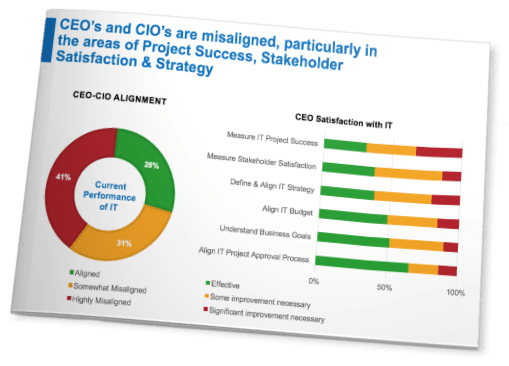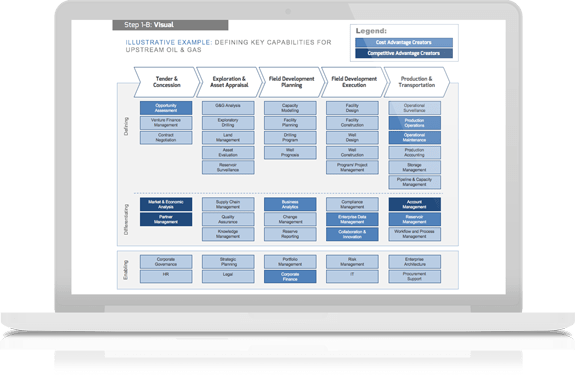This content requires an active subscription.
Contact one of our representatives for assistance.
+1-519-432-3550 (International)
Industry Insights Designed to Help You Lead Digital Transformation
With Info-Tech's Industry Roundtables & Benchmarking, you will never again wonder "what are my peers doing?", "how do I compare?", or "what should I be doing?".
Industry Insights & Best Practices


- Industry-Specific Research
- Reference Architectures
- Industry Trends
- Top Technologies
Executive Peer Groups


- Executive Collaboration
- Peer-to-Peer Knowledge Sharing
- High-Impact Discussion Topics
Industry-Specific Advisory Services

- Digital Transformation
- Linking Business & IT Value Maps
- Advisory Assistance to Help You Build Your IT Strategy
- Peer Benchmarking
Industry Roundtable Events
Durable Goods - Critical Projects
Deep Insights Tailored to Your Industry
1

Business-Aligned IT Strategy
Understand the capabilities and focus areas required to meet your industry’s needs and enable value creation.
2

Top Industry Trends
Identify resource, process, and environmental trends impacting your industry. Implement strategies to mitigate specific risks and take advantage of all relevant opportunities.
3

Industry Benchmarking
Reveal the true state of your IT services, processes, spend, and staffing levels to align your priorities and resources. Benefit from peer data to get a reference point for how well you stack up.
4

Core Industry Technologies & Software Selection
Arm yourself with everything you need to provide the right solutions to meet the needs of your business stakeholders.
1
Business-Aligned IT Strategy
Strategy Alignment
Understand Modern Cybersecurity Solutions for Manufacturing IT & OT
- Info-Tech recognizes the role of CIOs in safeguarding smart factories. This research aims to empower CIOs with the knowledge and tools necessary to respond to immediate threats, anticipate and neutralize potential vulnerabilities, and secure a competitive advantage for their organizations.
- Info-Tech will provide:
- A comprehensive guide explaining the integration of cybersecurity measures and technologies into the design and operation of smart factories.
- A tool to help you assess cybersecurity risk across manufacturing operations including production lines, IT/OT networks, data storage areas, and supply chain interfaces.
Strategy Alignment
Priorities for Adopting an Exponential IT Mindset in the Durable Goods Manufacturing Industry
- Predict shifts in the market priorities.
- Enable a proactive positioning of technology spends.
- See modernization through Exponential IT that avoids disruption.
Strategy Alignment
Improve OT Governance to Drive Business Results
- Identify: Discover the methods, people, tools, and approaches that can be used to ensure you have a streamlined OT governance model in place.
- Prioritize: Further determine a tiered approach to assembling teams and tools.
- Align: After establishing your teams and understanding your gaps you will have a systematic approach for pulling in the right people with the right tools at the right time. Operations and IT will be tightly aligned.
Strategy Alignment
Build a Durable Goods Manufacturing Business-Aligned IT Strategy
- Establish the scope of your IT strategy by defining IT’s mission and vision statements and guiding principles.
- Perform a retrospective of IT’s performance to recognize the current state while highlighting important strategic elements to address going forward.
- Elicit the business context and identify strategic initiatives that are most important to the organization while building a plan to execute on it.
- Evaluate the foundational elements of IT’s operational strategy that will be required to successfully execute on key initiatives.
- Wrap all strategic information into a highly visual and compelling presentation that enables easy customization and executive-facing content.
Strategy Alignment
Durable Goods Industry Business Reference Architecture
- Demonstrate the value of IT’s role in supporting your organization’s capabilities while highlighting the importance of proper alignment between organizational and IT strategies.
- Apply reference architecture techniques such as strategy maps, value streams, and capability maps to design usable and accurate blueprints of your manufacturing operations.
- Assess your initiatives and priorities to determine if you are investing in the right capabilities. Conduct capability assessments to identify opportunities and to prioritize projects.
Strategy Alignment
Transform Manufacturing by Mitigating the Challenges of Industry 4.0 and 5.0
Manufacturers have realized that successfully adopting Industry 4.0 and 5.0 technologies is essential to remain competitive. From incorporating principles of circularity to reducing costs and and controlling emissions, emerging technologies will have a transformative impact on the industry.
Info-Tech will provide:
Strategy Alignment
Durable Goods Manufacturing Business-Aligned IT Strategy
- Learn about the ecosystem factors that are impacting the durable goods manufacturing industry and how your IT team is set from a PESTLE and SWOT perspective, with expert insights and takeaways to update your IT strategy.
Strategy Alignment
How CIOs Can Get Manufacturing Demand Planning Right
Improving demand planning has an impact on both the top-line and bottom-line.
Strategy Alignment
Operationalize Data Privacy for Durable Goods Manufacturing
- Durable goods manufacturing organizations must establish a unified privacy program that incorporates privacy principles into high-risk business processes.
- You need to provide concrete tools to enable business. Work with business departments by speaking the language they can comprehend and providing tools they can readily implement, such as data privacy policies, procedures, and workflows.
- It is imperative to gain visibility into personal data processing activities such as the types of data collected, business purposes for collecting it, and where it resides, etc.
2
Top Industry Trends
Top Trends
Reshaping the Ecosystem for Industry 4.0 & Industry Next
- Identify: As a methodology, strategic foresight flows from the identification of signals to clustering the signals together to form trends and uncovering what is driving the trends to determine which strategic initiatives are most likely to lead to success on an industry level.
- Prioritize: Further customize the scores to your manufacturing by tailoring the generalized weightings on an organization-specific level and determining the relevancy and timing to your operations. By doing so, your manufacturing can determine which trend and technology to prioritize for your Reshaping-the-Ecosystem initiative.
- Align: After establishing what trend and technology to prioritize, establish its benefits that closely align and promote the success of your business goals.
Top Trends
Factory of the Future – Smart Factory Trends for Durable Goods
- Identify: As a methodology, strategic foresight flows from the identification of signals to clustering the signals together to form trends, and uncovering what is driving the trends to determine which strategic initiatives are most likely to lead to success on an industry level.
- Prioritize: Further customize the scores to your manufacturing by tailoring the generalized weightings on an organization-specific level and determining the relevancy and timing to your operations. By doing so, your manufacturing can determine which trend and technology to prioritize for your Smart Factory initiative.
- Align: After establishing what trend and technology to prioritize, establish its benefits that closely align and promote the success of your business’ goals.
Top Trends
Durable Goods Manufacturing IT/OT Convergence Report
- IT/OT convergence will bring new levels of connectivity to the manufacturing shop floor, creating great opportunities for remote monitoring, predictive maintenance, and vendor support.
- Yet obstacles exist for Durable Goods Manufacturing CIOs, who are often not seen as innovators by operations staff. Learn how to overcome this issue and set the course for IT/OT convergence in your Durable Goods Manufacturing company.
Top Trends
Generative AI Use Case Library for the Durable Goods Manufacturing Industry
Info-Tech’s use case library provides practical guidance to help manufacturers accelerate value-driven Gen AI use case adoption.
Top Trends
Durable Goods Manufacturing Attracting and Retaining Talent Report
- Organizations are trying to become more agile and introduce new technology, but in many cases there is a need to retrain personnel or attract a different type of talent that is often hard to find.
- Learn about attracting and retaining talent and how it affects both your organization as a whole and IT specifically, including challenges and opportunities.
Top Trends
Durable Goods Manufacturing Industry 4.0 Report
- Industry 4.0 technology is lowering the entry bar and creating competition in many markets, forcing manufacturers to become more efficient to remain viable. As a leader in Durable Goods Manufacturing IT, your time to become a partner is now.
- Learn about the Industry 4.0 trend and how it affects both your organization and IT specifically, with expert assistance.
Top Trends
Integrate Artificial Intelligence Into Your Manufacturing Operations
- Identify the initiatives you are currently capable of undertaking. The lifeblood of AI is good data. See how you can use your current data before you get overwhelmed with the possibilities AI offers.
- Build the business case for AI around what is possible for your organization. Decide what you should be doing with AI based on what you are currently capable of doing.
- Assess your current skills and identify where you will need help from vendors. Knowing when to look outside of your organization for help will be critical to your AI success.
- Gain the support of the business by showing the quick wins your AI initiative will provide and the business pains it will help to solve. Provide regular communication on the progress of your AI initiative to ensure continued support from the organization.
Top Trends
Preparing for Technology Convergence in Manufacturing
- Build and deliver an IT update that focuses on what is most important.
- Achieve the buy-in you require while driving business value.
- Gain clarity on your scope, goals, and outcomes.
- Validate IT’s role as a strategic business partner.
- Tear down silos by identifying the strengths, weaknesses, and potential synergies between the IT and OT teams.
- Gain clarity on the current state and target state of IT/OT convergence maturity within the organization.
- Build effectiveness by defining roles and accountabilities within the IT and OT teams.
- Identify risks and benefits related to IT/OT convergence, guaranteeing the right balance.
- Ensure success by building a convergence plan with detailed initiative profiles.
- Prepare for plan approval, while developing clear communication and plan refreshes as needed.
3
Industry Benchmarking
Peer Benchmarking
Benchmarking Report: A Cross-Industry Comparison of IT Stakeholder Satisfaction
- Every industry has unique characteristics that can hamper progress or facilitate success in satisfying IT stakeholders. Reimagine your strategy by shifting the definition of who your peers really are.
- Discover which industries achieve high stakeholder satisfaction across 13 core IT services.
- Learn the characteristics that different industries have that can help or hinder IT success.
- Understand what your industry has in common with others that you can leverage to improve stakeholder satisfaction and overcome your own institutional barriers.
Peer Benchmarking
Durable Goods Manufacturing IT Stakeholder Satisfaction Benchmarking Report
- IT leadership needs to understand where their clients are unsatisfied with the quality of service they are receiving from IT.
- IT and OT departments need to develop closer governance models and share knowledge to leverage the benefits of many of the new technologies emerging in the sector.
- Understand important focus areas to address and insights into how your team compares with other Durable Goods Manufacturing IT organizations.
Peer Benchmarking
Durable Goods Manufacturing IT Staffing Benchmarking Report
- Many IT departments are already running lean, struggling to keep pace with never-ending demands from the business. IT staffing is stretched thin.
- By taking the IT Staffing Assessment diagnostic and participating in our unique IT Spend benchmarking, you will gain critical information to position your team to be seen as strategic.
Peer Benchmarking
Durable Goods Manufacturing IT Management & Governance Benchmarking Report
- Understanding your IT team’s perception of what’s important and how well they’re doing is central to identifying strengths, weaknesses, and potential misalignments with business priorities and expectations.
- Learn about how IT departments in your industry assess the importance and effectiveness of 45 IT processes to gauge your own alignment and identify select processes for targeted improvement.
4
Core Industry Technologies & Software Selection
Core Industry Technologies
Develop a Business Continuity Plan for Manufacturing
- Implement a structured and repeatable process that you apply to one business unit at a time to keep business continuity planning efforts manageable.
- Use the results of the pilot to identify gaps in your recovery plans and reduce overall continuity risk while continuing to assess specific risks as you repeat the process with additional business units.
- Enable business leaders to own the BCP going forward. Develop a template that the rest of the organization can use.
- Leverage BCP outcomes to refine IT DRP recovery objectives and achieve DRP-BCP alignment.
Core Industry Technologies
Real-Time Transportation Visibility (Logistic Visibility Systems)
- Predict problems and identify opportunities to streamline processes.
- Enable higher levels of customer satisfaction.
- See how processes can be streamlined to meet OTIF targets.
Core Industry Technologies
Harmonizing Complexity: Control Tower Integration
- Predict potential problems and identify corrective action.
- Enable higher levels of customer and employee satisfaction.
- See how effective the processes are in real-time.
Core Industry Technologies
Bring Your Factory to Life With Smart Manufacturing 5.0
- Predict any potential problems or roadblocks.
- Enable higher levels of collaboration and quality.
- See greater efficiency and customer satisfaction.
Core Industry Technologies
The Connected Factory
- Identify: The kinds of compliance, certifications, standards, and regulatory activities that are important for your business sector and products.
- Prioritize: Further determine which tools can be used for tracking and tracing information, for conducting internal audits, and for generating reports for governing bodies.
- Align: After establishing what technologies are needed for compliance you will form the team in accordance with initial setup and ongoing management of compliance across all suppliers as well as considerations for management of in-transit control processes such as customs and CTPAT.
Core Industry Technologies
Using Supply Chain Control Tower for Competitive Differentiation
A supply chain control tower allows organizations to:
- Predict problems across the supply chain.
- Enable real-time information and decision-making capabilities.
- See where goods are and any bottlenecks that may be occurring.
Core Industry Technologies
Deliver Operational Efficiency Through Predictive Maintenance
- Predict: problems based on tolerance.
- Enable: proactive actions (predictive instead of reactive maintenance).
- See: prevention of downtime, increased productivity, and higher customer satisfaction.
Core Industry Technologies
Autonomous Technologies in Manufacturing
The deployment of industrial robots in manufacturing can yield a wide range of impactful results, transforming various aspects of operations, productivity, and overall business success. Some potential results and impacts include:
- Enhanced Productivity: Industrial robots can perform tasks with high precision and consistency, leading to increased production speed and reduced cycle times. This heightened productivity can result in greater output and quicker order fulfillment.
- Improved Quality: Robots execute tasks with minimal variation, resulting in consistent product quality and reduced defects. This leads to improved customer satisfaction, reduced rework, and decreased waste.
- Optimized Resource Utilization: Robots can operate 24/7 without breaks, minimizing idle time and maximizing resource utilization. This efficiency leads to reduced energy consumption, optimized material usage, and improved overall resource management.
- Increased Flexibility: Modern robots are designed for versatility and easy reprogramming. Manufacturers can swiftly adapt to changes in production demands, allowing for rapid product line reconfiguration.
- Human-Robot Collaboration: Collaborative robots (cobots) can work safely alongside human operators, enhancing task efficiency and worker safety. This collaboration can lead to improved ergonomic conditions and reduced human fatigue.
- Data-Driven Decision-Making: Robotic automation generates vast amounts of data that can be analyzed to identify patterns, optimize processes, and make informed decisions for continuous improvement.
- Safety Improvement: Dangerous and hazardous tasks can be assigned to robots, reducing the risk of workplace accidents and injuries for human workers.
- Cost Reduction: While the initial investment in robotics can be substantial, the long-term cost savings from increased efficiency, reduced waste, and lower error rates can be significant.
- Competitive Advantage: Companies that embrace industrial robots can gain a competitive edge by offering higher-quality products, faster turnaround times, and improved customer responsiveness.
- Sustainability: Efficient resource utilization and waste reduction achieved through robotic automation can contribute to improved sustainability efforts, leading to reduced environmental impact.
Core Industry Technologies
Generative AI in Digital Twins
The deployment of Gen AI with digital twins can empower manufacturers with predictive insights and real-time solutions. Manufacturers can improve their operational efficiency, innovation capabilities, and overall competitiveness using cognitive twins. Gen AI also improves resilience, risk management, and sustainability when used in conjunction with digital twins.
- Enhanced Analytics: Predict future states of the system and identify potential issues or failures.
- Optimized Performance: Optimize system and process performance, resulting in improvements.
- Improved Decision-Making: Create new, innovative designs and solutions, resulting in novel products and services.
- Improved Resilience: Enhance supply chain visibility and predict potential disruptions.
- Sustainability and Waste Reduction: Reduce waste and energy consumption, leading to more sustainable operations.
- Rapid Changes: Enable digital twins to adapt in real-time to changes in the environment.
- Risk Management: Assess and simulate various risk scenarios, enabling proactive risk management.
- Improved Modeling: Create accurate simulations of complex systems to develop and test new concepts quickly.
Core Industry Technologies
Empower Your Manufacturing Organization With the Potential of Intelligent Automation
Intelligent automation adds significant value to organizations. Intelligent automation has a variety of real-world applications and can simplify processes, reduce resource use, and improve operational efficiencies.
- Extend and speed up innovation, automate R&D, and integrate products and services.
- Streamline supply chain operations and enable access to accurate information.
- Improve customer experience by automating sales, services, and marketing.
- Streamline core corporate processes across finance, sales, HR, and IT.
Core Industry Technologies
Digital Twins in Manufacturing
Embracing digital twin technology in the manufacturing industry offers a myriad of advantages, including:
- Enhanced Product Development: Digital twins enable rapid prototyping and virtual testing, reducing the time and costs associated with physical prototypes.
- Optimized Production Processes: Manufacturers can simulate different production scenarios to identify bottlenecks, optimize workflows, and improve overall efficiency.
- Predictive Maintenance: Digital twins facilitate predictive maintenance by analyzing real-time data, allowing businesses to address maintenance needs before equipment failure occurs.
- Reduced Downtime: With real-time monitoring and predictive capabilities, digital twins help minimize unplanned downtime, leading to increased productivity.
- Improved Quality and Safety: Manufacturers can ensure product quality and safety by identifying and rectifying issues in the virtual environment before they manifest in the physical world.
- Informed Decision Making: Data-driven insights from digital twins empower manufacturers to make well-informed decisions, driving continuous improvement.
- Remote Monitoring and Control: Digital twins enable remote monitoring and control of assets and processes, enabling efficient management across distributed locations.
Core Industry Technologies
Sustainable Autonomous Packaging Solutions
Failure to define and meet sustainability goals will mean:
- Significant reputational damage in addition to fines and legal action
- Inability to remain competitive in an evolving marketplace
- Being a less attractive option for customers actively looking for more sustainable solutions
Core Industry Technologies
Adopt Blockchain for Supply Chain Transparency
- Distinguish blockchain from bitcoin by introducing a business-centric definition of blockchain around its unique and competitive technological features.
- Discover successful blockchain use cases in different industries; business leaders can leverage tangible real-life examples to interpret the impact of blockchain on their own industry.
- By analyzing the value chain of their business, CIOs can understand stakeholder pain points and craft a blockchain use case around them.
Core Industry Technologies
Advanced Inventory Management
Effective, technology-led inventory management can help address supply chain challenges. This research presents a playbook to deploy advanced technology and improve your inventory management maturity. Critical components of this playbook include an overview of inventory management systems and their advanced capabilities, an introduction to KPIs for effective performance management, and a technology maturity map to show you what good inventory management looks like. This will ultimately arm you with the ability to plan better, procure more efficiently, and fulfill in an optimized manner across more channels, customer types, and geographies.
Core Industry Technologies
Select a PLM Solution to Make Better Products
- Our methodology will address the issues presented using a vendor feature–set based approach to showing the client the art of the possible for PLM.
- Drawing on experience from nearly three dozen analyst engagements pertaining to PLM, half of which involved the manufacturing sector, our methodology enables the member to find a structured approach to vendor selection for this complex application category.
- Moreover, by utilizing Info-Tech’s vendor landscape and executive primer, the member and their business stakeholders can be confident they are taking the right approach to selecting a PLM solution.
Core Industry Technologies
Durable Goods Manufacturing IoT Platforms Report
- IoT technology is adding a new level of visibility, traceability, and utilization of goods and machines in the manufacturing process.
- By providing real-time utilization information, organizations can react quickly to address capacity issues, reduce machine downtime by anticipating failure before it happens, and improve the overall quality of the product.
- Gain insights into IoT technology and how CIOs are playing a larger role in its evolving implementation.
Core Industry Technologies
Durable Goods Manufacturing Autonomous Mobile Robots Report
- The introduction of autonomous mobile robots (AMRs) that can work independently around the clock, achieving a higher degree of quality, is forcing organizations to review and redesign many processes.
- Robots are working side by side with humans to help eliminate errors and improve product quality.
- Learn about AMRs and how they affect both your organization as a whole and IT specifically, including challenges and opportunities.
Core Industry Technologies
Durable Goods Manufacturing Additive Manufacturing Report
- Additive manufacturing technology, using 3D printing, allows simpler and faster model creation during the prototyping process and with IoT will redefine the supply chain process.
- 3D printing has the potential to revolutionize the industry by adding degrees of personalization and flexibility. Learn about this technology and how Durable Manufacturing CIOs are starting to play a key role in its implementation.
Latest Durable Goods Notes
Short, tailored research notes aimed at providing you with timely insights, relevant to your industry. Hot off the press, these notes will be published regularly and pair great with your morning coffee.
Meet the Manufacturing Sector Executive Services Leadership Team
November 7, 2023
Manufacturing is big business for Info-Tech, and so is our dedicated Manufacturing research and advisory services team’s ambition: Ensure that our members in manufacturing companies consistently receive exceptional value from their investment with Info-Tech! We do that by providing material, ongoing support for IT leaders in manufacturing on key IT initiatives, personal/professional development, peer networking, and career advancement.
Manufacturing: Advice From the COVID-19 Roundtable
March 30, 2020
On March 24, 2020, Info-Tech’s industry practice hosted a Manufacturing Industry Roundtable with the specific focus of identifying the impact that the COVID-19 pandemic is having in the industry. This is a summary of the roundtable discussions around three key issues.
Select a PLM Solution to Make Better Products – Executive Brief
February 19, 2019
Read this Executive Brief to understand how to turbocharge your company’s product management capabilities with a product lifecycle management tool.
Preparing for Technology Convergence in Manufacturing – Executive Brief
December 12, 2018
Read this Executive Brief to understand why better decisions, increased flexibility, reduced costs, and focused innovation are only a few of the benefits that come from successful IT/OT convergence.
Integrate Artificial Intelligence Into Your Manufacturing Operations – Executive Brief
July 4, 2018
Read our Executive Brief to understand why you should consider integrating AI into your manufacturing operations.









































